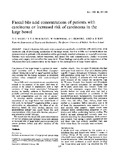| dc.contributor.author | Mudd, DG | |
| dc.contributor.author | McKelvey, ST | |
| dc.contributor.author | Norwood, W | |
| dc.contributor.author | Elmore, DT | |
| dc.contributor.author | Roy, AD | |
| dc.date.accessioned | 2013-06-11T09:14:12Z | |
| dc.date.available | 2013-06-11T09:14:12Z | |
| dc.date.issued | 1980 | |
| dc.identifier.citation | Faecal bile acid concentration of patients with carcinoma or increased risk of carcinoma in the large bowel. Mudd DG, McKelvey ST, Norwood W, Elmore DT, Roy AD. Gut. 1980 Jul;21(7):587-90. | en |
| dc.identifier.uri | http://www.ncbi.nlm.nih.gov/pubmed/7429321 | |
| dc.identifier.uri | http://erepository.uonbi.ac.ke:8080/xmlui/handle/123456789/31377 | |
| dc.description.abstract | Faecal 3-hydroxy bile acids were assayed enzymatically in patients with carcinoma, or at increased risk of developing carcinoma of the large bowel. No rise in bile acid concentration was demonstrated in patients with ulcerative colitis, previously resected adenoma, or resected carcinoma. Patients with carcinoma, before treatment, had faecal bile acid concentrations similar to control values, and surgery did not affect the mean level. These findings cast doubt on the importance of the 3-hydroxy bile acid concentration in the faeces in the pathogenesis of large bowel cancer. | en |
| dc.language.iso | en | en |
| dc.title | Faecal bile acid concentration of patients with carcinoma or increased risk of carcinoma in the large bowel. | en |
| dc.type | Article | en |
| local.publisher | Surgery and Biochemistry, The Queen's University of Belfast, Northern Ireland | en |


